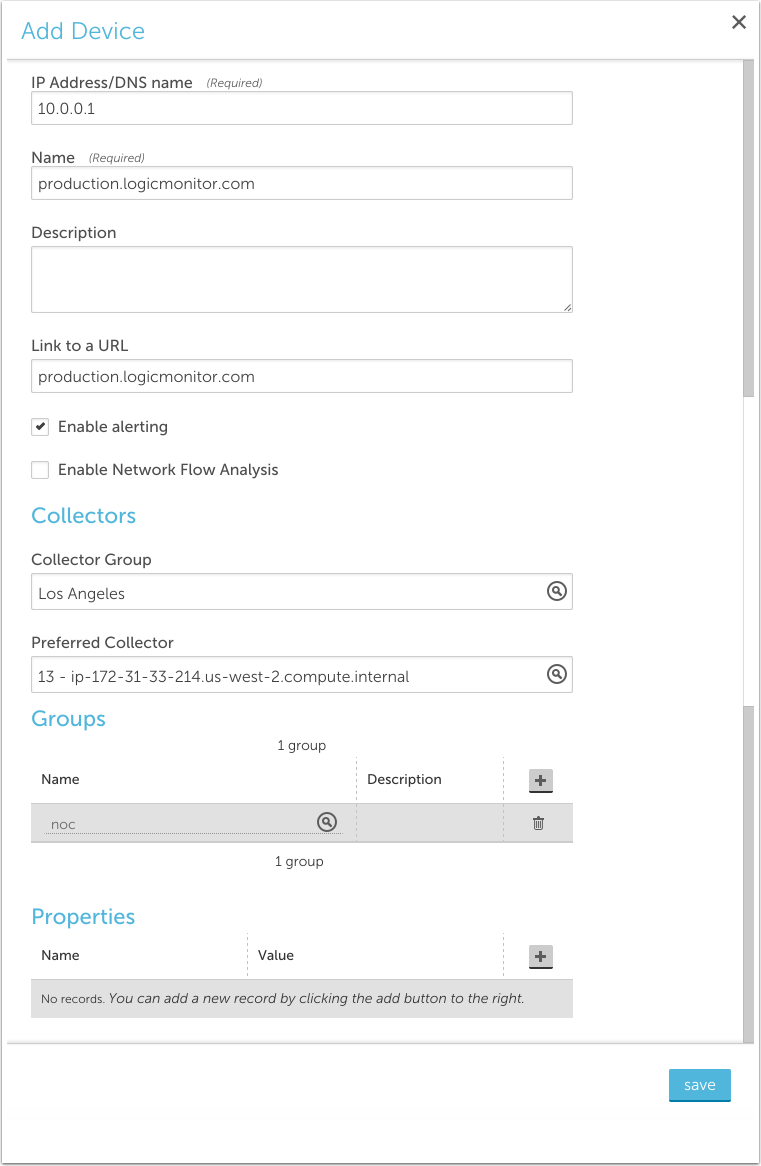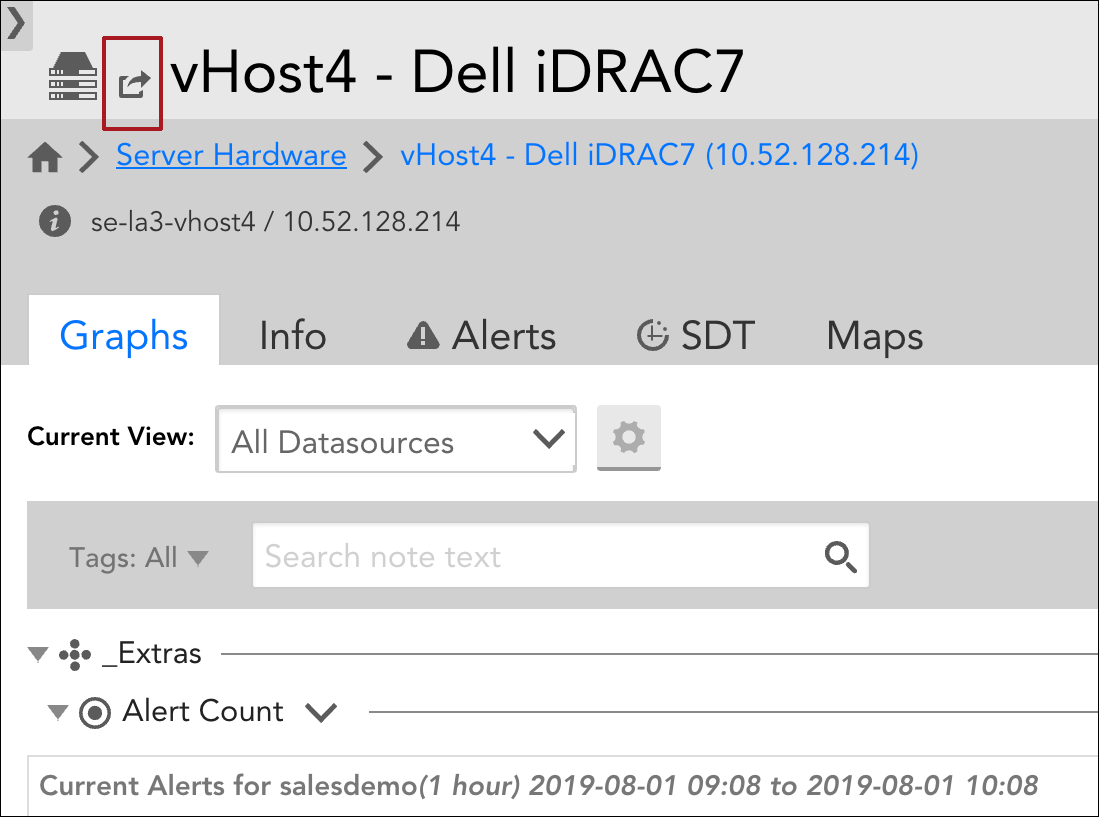Disclaimer: This content applies to the legacy UI and is no longer maintained. It will be removed at a future time. For up-to-date content, see . At the time of removal, you will automatically be redirected to the up-to-date content.
Adding Devices
Last updated - 25 July, 2025
Overview
As discussed in the following sections, devices can be added to your LogicMonitor account for monitoring using several different methods. Once a device has been added and communication with that device is established, LogicMonitor will add the device to the Resources page of your LogicMonitor account. Device information is stored as system properties which are visible on the devices’s Info tab. As discussed in Defining Authentication Credentials, you can manually add properties to specify login credentials and custom port settings for that device. DataSources and other LogicModules will automatically be applied to the device based on the device information discovered.
Manually Adding Devices
When manually adding a device, you can select between the wizard and expert mode. Wizard mode will verify that your device is correctly configured for monitoring, while expert mode will assume you are providing correct device configuration.
Wizard Mode
From the Resources page, select Add | One Device | Wizard. LogicMonitor’s device wizard will walk you through a four-step process:
- Enter the IP address or DNS name of your device.
- Select the primary Collector for the device you are adding. This Collector will be used to establish communication with the device using standard monitoring protocols.
Note: Duplicate devices (i.e. duplicate IPs) can be added as long as they are monitored with distinct Collectors and have unique display names.
- LogicMonitor will attempt to communicate with the device using standard monitoring protocols.
- If LogicMonitor cannot establish communication, you will be prompted for more information regarding the device type. You may also need to provide any passwords set for the monitoring protocols that apply to your device (e.g. the rocommunity for a Linux server).
Note: You can also use this area of the wizard to set and test your SNMPv3 credentials, including User Security Name, Authentication Key, Authentication Protocol, Privacy Key, and Privacy Protocol. The wizard does not currently support setting/testing SNMPv3 AuthNoPriv (no encryption) or NoAuthNoPriv (no password and no encryption), but SNMPv3 related device properties can still be manually set for these methods, as discussed in Defining Authentication Credentials.
- Once you’ve completed the device wizard to set up the basic parameters for your new device, you can set more additional configurations (e.g. device URL, alert disabling, NetFlow analysis, group membership) by locating the new device in the Resources tree and, from its detail page, clicking the Manage button to open the Manage Device dialog. For more information on the additional settings available for configuration, see the following section as the Manage Device dialog carries all the same configurations that you establish when setting up a device in expert mode.
Expert Mode
If you already know which properties are needed to establish communication with your device, or know that these properties are configured at the group level, the expert mode is an easy way to quickly add devices to your LogicMonitor account.
To add a device in expert mode, select select Add | One Device | Expert from the Resources page. This opens the Add Device dialog, which holds the following configurations.
IP Address/DNS Name
Enter the IP Address or DNS Name of your device into the IP Address/DNS name field. This will be used by the Collector to establish communication.
Note: Duplicate devices (i.e. duplicate IPs) can be added as long as they are monitored with distinct Collectors and have unique display names.
Name
In the Name field, enter a display name for the device. The display name will be used throughout the application. Device display names cannot include the operators and comparison functions listed as part of LogicMonitor’s datapoint expression syntax.
Description
In the Description field, enter a description for the device. This description will spawn a system.description property. This can be used within device searching functionality and for dynamic groups.
Link to a URL
In the Link to a URL field, enter the device URL if one exists. A device icon will then display next to the device name in the header of the device detail page. When the icon is clicked, a new browser tab opens to the URL. This field is most commonly used to link to management portals or troubleshooting documentation.
Enable Alerting
The Enable Alerting checkbox is enabled by default. If unchecked, device data will be collected but no alerts will be generated. Users commonly disable device alerting if datapoint alert thresholds need to be adjusted prior to alert generation.
Enable Network Flow Analysis
NetFlow (Network Traffic Flow Analysis) data can be monitored for any device with sflow, jflow, or netflow information. When the Enable Network Flow Analysis checkbox is selected, you’re given the option to select a separate Collector for NetFlow data. As discussed in Configuring Monitoring for NetFlow, you must also enable NetFlow data collection on the device itself.
Collectors
In the Collectors section, use the Collector Group field to filter the list of available Collectors that can be assigned as the preferred Collector from the Preferred Collector field. The preferred Collector is the primary Collector responsible for collecting data from the device. Backup Collectors will automatically be assigned if the preferred Collector fails over.
Groups
In the Groups section, you can assign your device to one or more device groups. If you have anything selected in the Resources tree at the time you began adding this new device, LogicMonitor automatically assigns the group, if any, that encompasses whatever is currently selected. As discussed in Device Groups Overview, grouping your devices in LogicMonitor can make management significantly easier and save you time when configuring alert thresholds, dashboards, reports, alert routing, and device properties.
Properties
In the Properties section, you can assign properties to your device, including authentication and custom information. For more information on assigning properties, see Resource and Instance Properties.
Adding Devices via NetScans
You can configure LogicMonitor Collectors to scan an IP range periodically and add discovered devices into the system automatically. For more information on configuring network scans, see Creating NetScans.
Adding Devices via LogicMonitor’s API
Adding devices via the API can be extremely useful, particularly if you are looking to do a bulk upload or want to automatically add a device to monitoring as it’s spun up by a configuration management tool such as Puppet or Ansible. For more information on using LogicMonitor’s REST API to add devices when they boot, see REST API Developer’s Guide.





